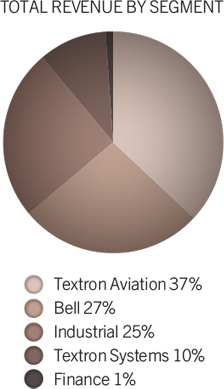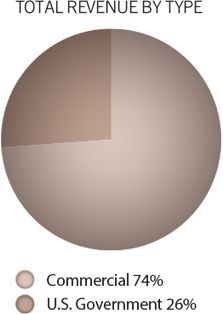In 2021, we experienced a rebound in customer demand for our commercial products, our businesses executed well across our company and we made progress on a number of our commercial products and military programs. We posted strong results with revenues of $12.4 billion and segment profit of $1.1 billion, increases of 6% and 51%, respectively, year-over-year. During the year, we generated net cash from operating activities from our manufacturing businesses of $1.5 billion and purchased 13.5 million of our shares, returning $921 million in cash to our shareholders.
Strong year for commercial products
With our strategy at Textron Aviation of making long-term investments in new product development and service capabilities, our robust product lineup positioned us for success as we saw a solid recovery in the business jet market. Business jet deliveries were up 27% year-over-year, and we increased our backlog at the segment by $2.5 billion, 157%, resulting in $4.1 billion of backlog at the end of 2021.
As new aircraft rolled off our production lines, we continued our commitment to develop new aircraft and introduce upgraded aircraft to the market. Our new Cessna SkyCourier twin-engine, large-utility turboprop moved closer to certification and, by year-end, had completed a total of more than 2,100 hours of flight test activity. Certification and first deliveries of the SkyCourier are anticipated in the first half of 2022. Meanwhile, the Beechcraft Denali, our new single-engine turboprop in development, began its test flight program with a milestone first flight in November.
The Denali is powered by the new GE Aviation Catalyst engine, a more sustainable engine that burns up to 20 percent less fuel than older turboprop engines.
In addition to our new models, we added three product upgrades to our Cessna Citation lineup. Each model, the XLS Gen2, CJ4 Gen2, and M2 Gen2, offers enhanced passenger comfort and new design elements. We also cleared the way for customer deliveries into Europe for our Citation Longitude, CJ4 Gen2 and Beechcraft King Air 360 and King Air 260 with the receipt of European Aviation Safety Agency (EASA) type certification for these aircraft.
Reflecting stronger demand across our commercial products and services, Bell saw solid commercial order activity for the year and increased commercial revenues. Bell completed the 300th Bell 505 delivery and announced aircraft purchase agreements and deliveries into new countries, including Uganda and Ethiopia.
Textron Specialized Vehicles introduced the E-Z-GO Liberty, the industry’s first vehicle with four forward-facing seats in a compact, golf-car-sized footprint, which received an enthusiastic reception from customers. Using the lithium-ion battery technology that powers E-Z-GO’s successful line of ELiTE golf cars, the Liberty sold out available production in its initial run. Lithium-ion technology is also powering Textron GSE’s new TUG 660 Li belt loader with quiet, energy-efficient and low-cost operation for our airline and air-freight customers. To expand ground support equipment for use in airports globally, we established a strategic collaboration with GM in which GM will provide electric vehicle components to electrify Textron GSE’s TUG line of baggage tractors and belt loaders.
Kautex won new contracts with automotive OEM customers, successfully securing eight contract awards for its hybrid electric fuel systems. Kautex has also developed and begun to market the Pentatonic battery system, a customizable, lightweight battery housing with thermal management capabilities for use in electric vehicles, from hybrid to fully battery-powered.
Moving ahead with military opportunities
In 2021, the Bell V-280 Valor continued to demonstrate its outstanding capabilities to the U.S. Army for the Future Long Range Assault Aircraft (FLRAA) program. The down-select and award on the FLRAA program is expected in 2022. Offering unmatched speed, range and maneuverability, the V-280 finished its flight test program in June, having flown at more than 300 knots and completing more than 214 flight hours over a three-year period.
We also continued the development of the Bell 360 Invictus competitive prototype for the Future Attack Reconnaissance Aircraft (FARA) program. Bell completed more than 75 percent of the build, making significant progress on the fuselage, main rotor blades, gearbox assembly and other high-value components.
Textron Systems won a number of contracts with our military customers for ground-, sea- and air-based systems and products. We were awarded a contract with the U.S. Army to upgrade our existing Shadow® Tactical Unmanned Aircraft System (TUAS) to the Block III configuration, including Contractor Logistics Support, field support services and engineering support. This award followed a highly successful test and evaluation of the Block III configuration in late 2020.
Our Aerosonde® Unmanned Aircraft System (UAS) continues to provide critical Intelligence, Surveillance and Reconnaissance (ISR) mission services in support of U.S. Special Operations Command (SOCOM) and the U.S. Navy. Aerosonde has now amassed over 550,000 flight hours of service, and the program received a key multi-year task order from the U.S. Navy for maritime ISR services. Our Common Unmanned Surface Vehicle (CUSV®) demonstrated its survivability by successfully completing underwater explosion shock testing. The highly adaptable platform can carry a variety of payloads including support of mine warfare missions for the U.S. Navy.
Textron Systems was awarded a U.S. Marine Corps Advanced Reconnaissance Vehicle (ARV) prototype agreement for its purpose-built Cottonmouth™ vehicle. With this prototype agreement, Systems will produce a Cottonmouth vehicle that will go through rigorous testing and evaluation over a 22-month period. In Fiscal Year 2024, the Marine Corps is expected to select a single contractor for continued development leading to production.
Building on its robotics technology capabilities, Textron Systems delivered four RIPSAW® M5 vehicles as part of the Robotic Combat Vehicle-Medium program. We also delivered a fifth all-electric version of the RIPSAW M5 to Robotics Research, LLC. A modular platform with an all-electric system, the M5-E variant offers speed, endurance and extreme mobility. This variant supports the U.S. Army’s Armament and Lethality integration efforts by incorporating a variety of sensors that allow additional systems—on the ground, in the air or in the water—to communicate with one another. Textron Systems participated in the Army Futures Command’s Project Convergence 21, providing four of the five vehicles used in this week-long exercise to integrate artificial intelligence, robotics and autonomy to plan for future operations.
Textron Aviation Defense announced a contract with the Royal Thai Air Force for eight Beechcraft AT-6 Wolverine aircraft, ground support equipment, spare parts and other equipment. This contract established Thailand as the international launch customer for the U.S. Air Force’s latest light attack aircraft.
New horizons with eAviation and sustainability
Recognizing the role of emerging electric technologies in the future of aviation, we launched our eAviation initiative. eAviation leverages the resources and expertise across our aviation businesses to develop new opportunities in aircraft using electric propulsion systems. We plan to expand these efforts and increase our investment in developing technologies to accelerate the shift to sustainable flight, including eVTOL and fixed-wing aircraft.
We continued to take steps to address our impact on the environment in our operations and products while helping our customers to minimize their carbon footprint. Our Cessna piston-powered aircraft were approved to use more environmentally friendly aviation gasoline, including 91- and 94-octane unleaded and 100-very-low-lead fuel, that burns cleaner than higher-leaded fuels currently used on most aircraft. Separately, Textron Aviation signed an agreement with Avfuel to provide an ongoing supply of its Sustainable Aviation Fuel (SAF), making us the first OEM customer to take the fuel at regular intervals. SAF currently is the most effective way to reduce a flight’s carbon footprint.
Bell also became the first rotorcraft customer to receive SAF from Avfuel, incorporating it into all Bell Training Academy and customer demonstration fleet aircraft to decrease the environmental impact of Bell’s operations. Bell continued to explore other ways to reduce carbon emissions by testing electrically powered technology in new vehicles like the Bell Autonomous Pod Transport (APT).
Textron Specialized Vehicles has leveraged its expertise in electric drivetrains and lithium-ion battery technology across its brands and product lines. From golf and turf to ground supprt equipment and powersports, customers are increasingly seeking out electric vehicles to reduce their carbon footprint and increase energy efficiency. Sales of ELiTE lithum-ion powertrains used in E-Z-GO and Cushman products have increased 30 percent over the past two years as engineers work towards integrating this technology into more of our products. In addition, our E-Z-GO gas-powered vehicles, utilizing our EX1 gas-powered engines, are the cleanest gas-powered golf car engines in the industry with 60 percent fewer emissions than the closest competitor.
On the operations side, Textron Aviation now uses 79 percent renewable energy to power its U.S.-based facilities. This is the highest percentage of green energy of all business and general aviation manufacturers participating in the U.S. EPA’s Green Power Partnership and equates to nearly 212 million kilowatt-hours of green power annually. Through a multi-year agreement with Evergy, Textron Aviation’s Kansas facilities are receiving electricity through renewable, zero-emission wind energy from Soldier Creek Wind Farm in Manhattan, KS.
A year of growth and positioning us for the future
We had a year of strong performance and execution across our businesses. With the long-term investments that we’ve made in our new product development, our service and sales networks and our manufacturing processes, we were ready to respond to 2021’s increased commercial demand. We continued to deliver on our customers’ expectations and moved forward on our military programs, positioning us for future growth. None of this happens without the talent and hard work of our global workforce, who have done an outstanding job to make our success possible. With this talent and through our growth strategy, we are well-positioned to achieve our goals and deliver long-term value for shareholders.

Scott C. Donnelly,
Chairman and Chief Executive Officer



